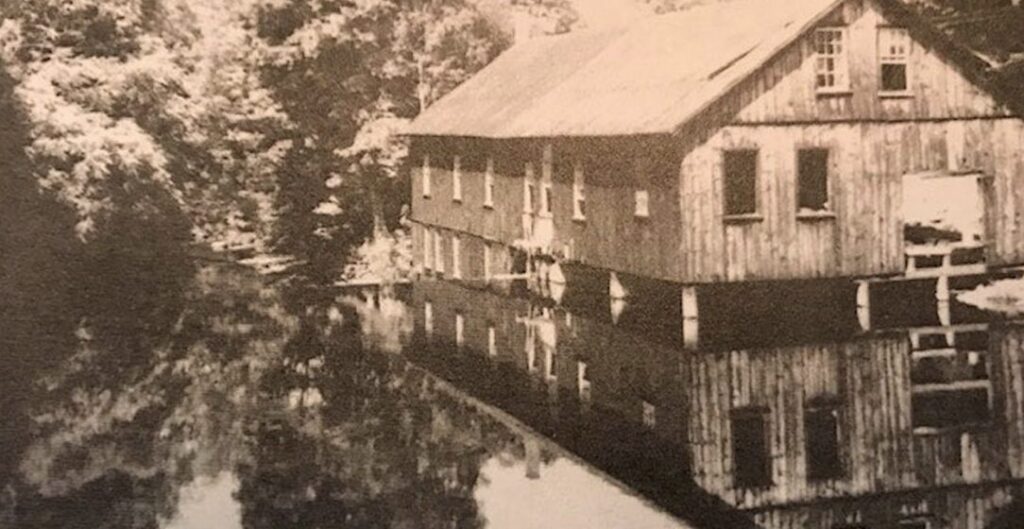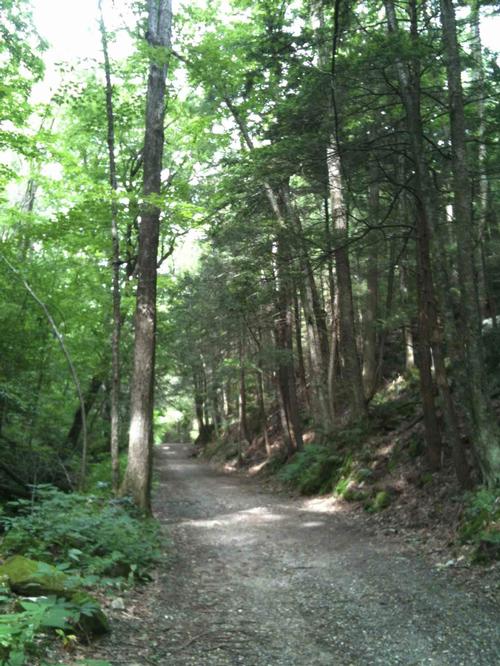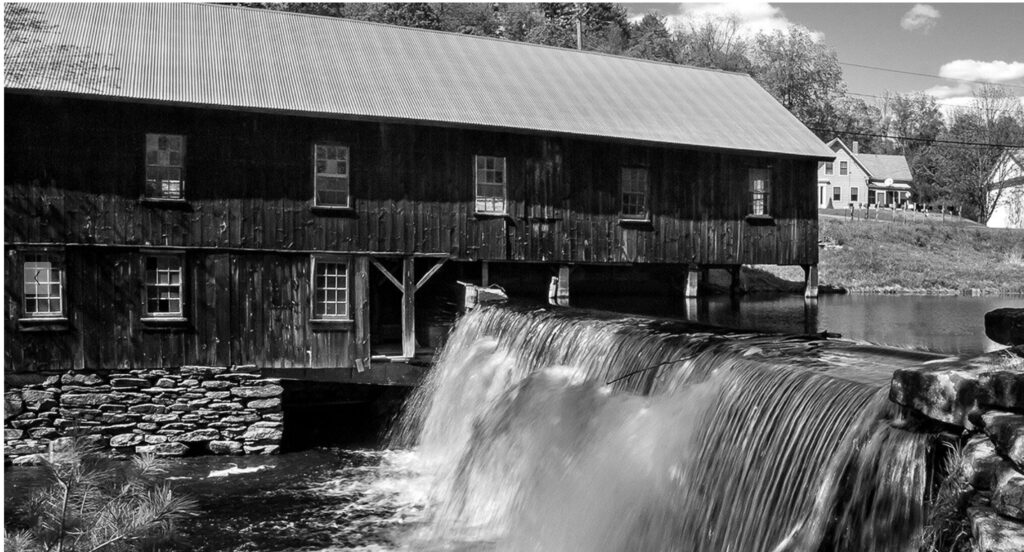Amherst’s Neighboring Towns: Leverett (Part 2)

North Leverett Sawmill (origins 1770's). Photo: Friends of the North Leverett Sawmill
Amherst History Month by Month
This column is the ninth in a 10-part series about towns surrounding Amherst. Previous columns covered Pelham, Shutesbury, Sunderland, Hadley, Belchertown, Granby, Leverett (Part 1) and South Hadley. For a listing of all previous “Amherst History Month by Month” columns, look here.
Leverett comprises several distinct areas that were once independent villages (e.g. Moore’s Corner, Dudleyville, North Leverett, South Leverett Center) many of them historic both in time-period and visual appearance. You could characterize Leverett as a successful spatial model of a decentralized community. For a small town, there are an impressive seven cemeteries! There’s even a legend that persists that in past times, more souls were among the dead than the living. I am not sure the joke is true today as Leverett has tons to recommend it. It has nine historic school districts although there are not that many school houses that survive today in those districts. As in other western Massachusetts towns, some have been converted into private dwellings and one is now the home of the Leverett Historical Society

Over time, the heartbeat of civic-minded Leverett has changed. If we shift back south to the historic town center by Leverett Pond, Town Hall presents modestly to the world as a two-story gable-end structure that still feels like an old New England meeting house inside. The grander of Leverett center’s structures, the First Congregational Church (United Church of Christ denomination) was built on the site of the town’s first meeting house in 1838. Back in the late 1700s and into the early 1800s, this congregational church, like many other congregational churches in New England, experienced a schism, and a dissenting group of churchgoers formed an alliance with the Montague Baptist Church, which had formed in 1767. The outcome was a second church, this one in North Leverett, the North Leverett Baptist Church.

Another shift in Leverett center took place more recently, when what was once the Bradford Field Memorial Library, designed by Karl S. Putnam and built in 1916, now houses part of the collections of Leverett’s historical society and a new public library was completed in 2002–2003 just south of the elementary school. To me, Leverett’s new library building in sheltered woodland is part of the town’s recent civic core. The building is about halfway between the historic center of town by the pond and Cave Hill Road, leading to North Leverett. Next door to the library and elementary school is the town’s public safety complex (fire, police, EMT, and department of public works).

In past centuries, Cave Hill Road was not the only way to get from Leverett center to North Leverett and the adjoining village of Moore’s Corner: Rattlesnake Gutter Road was open to the public for most of the year. “The Gutter” is still a wondrous and walkable throughfare, in a magical chasm filled with huge stone boulders (and wildflowers including trillium in early spring). It was discontinued as a public road due to the cost of maintenance and repairs, but is still accessible by foot.

But before we leave Leverett center to explore the north end of town more fully, it is worth mentioning the Leverett Arts Co-op, which is housed in an old factory building, the Beaman-Marvell Box Factory that made wooden shipping boxes. The building dates from 1903 and employed up to 50 people but by the 1960s it had become vacant. Then a sculptor and his family bought it with the idea of offering art classes and educational programs. In 1966–67 it opened to the public and quickly became a contributing property within the Leverett Center Historic District as “both an historically significant industrial building and as a community-based arts center” Presently, there are public events, exhibitions, and programs, and the studios of about 12 artists.

I remember ‘discovering’ North Leverett Road when I first moved to this area. It is an interesting roadway established during the Colonial period connecting Sunderland and Leverett to Shutesbury and it passes by some significant places along the way. The Montague Retreat Center, once the site of a well-known commune that operated from circa 1968 to 2002 is off to the left if you are coming from Route 63. Dotted around North Leverett center at the intersection of Cave Hill Road and North Leverett Road, are the North Leverett Baptist Church and Joseph Slarrow’s sawmill, sometimes called the ‘Waterwheel Lumber Mill.’ Along the road here and west towards Route 63 are the remains of a series of canals (on private land) that mostly follow the path of the Sawmill River. From the material evidence that survives it is possible to point to rural Leverett’s very entrepreneurial past, dating back to the Federal period (the late 1700s/early 1800s),when new settlers were determined to envision productive enterprises using waterpower.

This year, a lovely walking trail next to the river was created by Leverett residents whose vision includes the rehabilitation of the historic mill to turn it into a living history and technology museum.
North Leverett is lucky to have the Leverett Village Food Co-op situated on the right, coming from Route 63, in the middle of Moore’s Corner, another former village. This neighborhood has its own historic mill called Watson’s Mill and at one time, its own modest, wood-frame store called Watson’s General Store, later Moore’s Corner Store, and more recently The Mall at Moore’s Corner (that is a wonderfully dissonant contrast to what the word mall usually conjures up). The triangular “corner,” where Rattlesnake Gutter Road, North Leverett Road, and Dudleyville Road meet, is now the site of the co-op , which offers a wide variety of produce, baked goods, some made on the premises, staples like milk and eggs, frozen foods, sandwiches, wine and beer (the current manager is apparently a sommelier), and basics like soap and paper towels. There is even a cafe and beautiful outdoor playground area, with tables and benches, in an enclosed area surrounded by the old foundation of the Dexter Moore barn. While the co-op building dates from 1986, its roots go back to the early 1970s, and it continues to serve residents and visitors to Lake Wyola, Shutesbury, Wendell, and Montague. Long may it reign.
The road back to Rattlesnake Gutter runs in a southerly direction at an angle to the food co-op. The town voted to discontinue this road in 2023–’24, with the help of local resident Eva Gibavic, who grew up on it. Gibavic is the author of a book about Brushy Mountain, an arresting natural landscape between the Gutter and East Leverett, where Rolling Brook runs below wooded slopes. The area was historically part of a two-mile property requested by Sunderland — then known as Swampfield — in 1729. Signed by the Massachusetts General Court and the colonial governor, William Burnett, this transaction had the impact of extending what was to become Leverett east into what had historically been the lands of the Pocumtuc peoples. Gibavic’s book , “As Long as Trees Grow and Water Runs”, describes the history of Brushy Mountain from the 1700s to the present, beginning with the construction of the charcoal kilns that operated on nearby Hemenway Road until the 1970s, charting the story behind deeds and other written records, the topography and several sites of historic cellar holes. In the process of countless hours exploring the area and researching the stories of who lived there, she has uncovered centuries of settlement and resettlement. Now, Brushy Mountain has been returned to forest, much of it owned by Cowls Lumber as well as the Kestrel Land Trust.

Cave Hill Road is also the location of two Buddhist centers, one of which is the New England Peace Pagoda, built in 1985 at 100 Cave Hill Road. Traditional Buddhist structures of a prayer hall and stupa are present in this dramatic setting with trails marked throughout the property. If you want to visit, there is public parking off Cave Hill Road. As with all the lands in what we know as Leverett today, the bywords of the monks are wisdom indeed: be still, silent and know. Know that there are many other histories still surfacing and being recorded in our hillside and valley towns.


What’s not said about sawmills is what they did with the sawdust.
Yep, right into the river — it’s jaw-dropping to realize what was once considered perfectly acceptable, and the sawdust eventually sank, causing two problems. It sucked all the oxygen out of the water column as it decomposed, killing all the fish and shellfish, and it smothered the shellfish, e.g. oysters. It wasn’t just the raw sewerage that killed the rivers, although that didn’t help.
TOLERANT SKEPTICISM
A good motto to consider for universal adoption!
Just for the editor and staff: I greatly enjoy reviews of towns in the area. That information is not easily obtained by the casual reader. Thank you.
Dear Mr. Ogden
Yes, happy birthday to Leverett! My first article on Leverett mentioned the anniversary events. https://www.amherstindy.org/2024/11/29/amhersts-neighboring-towns-leverett/
Please find below a donation in Leverett to the Native Land Conservancy (the land is at the foot of Brushy Mountain and Doolittle Brook) “In the care of NLC, the land will now be honored with the name Nepesoneag, which has significant meaning to the Nipmuc people. ” https://www.nativelandconservancy.org/blog/xtfyr29tu64zj8qru2xgcteaednz1y-7964h-ea57a-rehg7